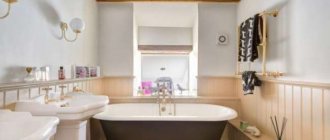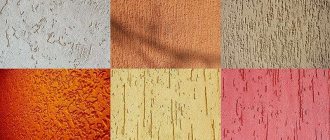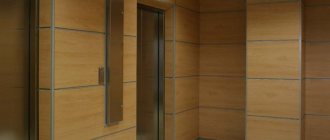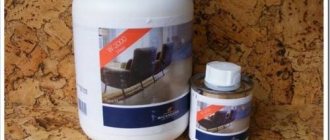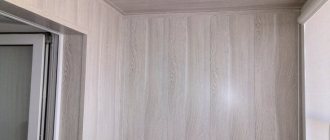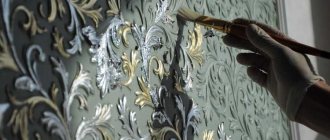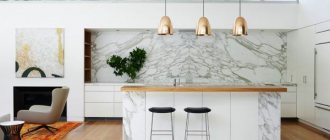Plastic panels are an excellent material that is widely used to add various decor to the surface. Conveniently, this product can be used in almost any room. There is an opportunity to create a truly unique interior. And decorating walls with plastic panels is a fairly simple undertaking that does not require construction experience. Although you still need to know how to do everything most correctly.
What are PVC panels
Plastic panels (lining) have another name - PVC. This is an abbreviated name for the main ingredient of the material - polyvinyl chloride. The production is quite simple and involves passing the molten substance through special molds. This creates a strip that is cooled and cut to the desired size. The result is an excellent finishing material that can withstand almost any temperature (within residential premises).
Wall panels vary in size:
- There are two types of thickness - five and ten (eight) millimeters. The second indicator is combined into one; there are identical additional elements for it.
- The width varies, ranging from twenty to thirty-seven centimeters.
- There are three main sizes in terms of height – 2.6 m; 2.7 m; 3m.
Of course, there are many more sizes. Thus, the width of the plastic lining reaches 120 cm. You can also make any desired non-standard to order.
Advantages and disadvantages
It is impossible to imagine a finishing and building material that would not have its pros and cons.
Modern PVC panels have a beautiful appearance, as well as many other advantages
Wall panels have the following advantages:
- The service life is practically unlimited.
- Excellent moisture resistance. When connected correctly, the seams create a complete seal.
- The material protects the room from extraneous noise.
- Reliability and good resistance to abrasion.
- The cellular structure provides additional thermal insulation. When covering walls with your own hands using lathing, additional space appears for the insulating layer.
- Modern technologies make it possible to create various types of decor. More recently, the choice was quite limited, if not primitive.
- Easy to install. No complex tools required.
- Low price compared to other products.
- Environmentally friendly.
Flaws:
- Inability to withstand constant temperature changes. This does not apply to seasonal phenomena.
- When a fire occurs, plastic elements release corrosive substances.
- Incorrect installation reduces many positive qualities to zero.
Like any other plastic, PVC panels are “afraid” of high temperatures, and when ignited they release harmful substances
On a note! Currently, there are panels that are distinguished by their ability to withstand high temperatures. But they must have special markings.
Material selection
Naturally, you want to quickly cover the walls with plastic panels, but you need to select them first. And this should be approached with the utmost care. After all, the final result depends on the correct choice. The following rules are taken into account:
- For bathrooms and shower rooms, as well as for all types of wet rooms, panels that are moisture resistant and have no relief are suitable.
- For corridors and balconies (loggias), it is better to choose products that are resistant to mechanical damage.
- Wall decoration with wall panels in living rooms is carried out with PVC coatings, which have different reliefs and patterns. They also imitate natural materials.
Plastic lining has good moisture resistance, so it is often used for finishing bathrooms.
When purchasing, you need to pay attention to the following indicators:
- Appearance of the packaging. It must be intact, without damage. It is important to choose material from the same batch.
- Number of cells. The bigger, the better. You can also navigate by weight. Light products are a sign of deficiency.
- Lock. To do this, check the two selected panels for connection - it must be reliable.
- Price. Products that are too cheap are most likely a fake.
Additionally, we suggest watching a video that explains how to select and attach wall panels.
Plastic panels - advantages and disadvantages of the material
Usually this material is compared with the only alternative option - ceramic tiles. You need to understand that finishing a bathroom with plastic is a budget-friendly way to renovate.
However, in terms of their characteristics, PVC panels are not much inferior to ceramic tiles. This modern material quickly gained popularity among craftsmen and beginners due to the ease of working with it and its reasonable cost.
The main advantages of PVC panels include the following:
- PVC has moisture-resistant qualities and is resistant to sudden and frequent temperature changes over a fairly wide range;
- plastic panels are available in a wide range of colors;
Bathroom finishing with mosaic-like PVC panels.
- PVC is safe for humans and has high environmental characteristics;
- PVC panels are quite easy to install;
- the price of decorative panels made of plastic is significantly lower than that of other materials;
- Caring for PVC coating is quite simple - this polymer is easy to clean with warm water and soap.
Advice! To care for plastic panels, you need to use only soft sponges. The use of hard brushes or abrasive cleaners may damage the PVC surface.
PVC panels also have vulnerabilities:
- with a sharp change in temperature, deformation of plastic panels is possible;
- The resistance to mechanical damage of this material is very limited - it is easily damaged by a strong impact or exposure to sharp objects;
- glossy PVC surfaces imitating natural materials look rather faded.
Faded color of panels in the bathroom.
Calculations
Covering walls with PVC panels requires preliminary calculations. They concern all stages of work. This helps to avoid problems in the future, as well as significantly save money and time.
Frame:
- The location of the profiles is taken into account. It can be vertical or horizontal. This depends on the installation of plastic panels. In any case, they are always perpendicular to the sheathing posts.
- The distance between them is also taken into account, which is 30 - 45 cm. From everything, the required number of frame parts is calculated (+ two profiles at the edges of the wall).
Fasteners:
- The number of dowel nails is taken into account in increments of 35-50 cm.
- There are 20-25 clasps per square meter.
Panels:
- The size of the wall and the selected panel is measured. One indicator is divided by the other, and the required amount is obtained.
- The material in the form of tiles is calculated based on square meters.
Additional elements.
This group includes all other parts and moldings. For calculations, measure the entire perimeter of the room. The number of external and internal corners is taken into account.
Additional elements that may be useful when decorating walls with plastic panels
On a note! All calculations are made with a margin of 10%. Such a reserve is due to the fact that various damage to products or other unforeseen circumstances are possible. Door and window openings are also taken into account.
Plastic as a material
Wall decoration with plastic panels has its advantages and disadvantages. They must be taken into account when making the final decision. The finishing material has the following advantages:
- Absolutely harmless. Many people are afraid of plastic because it is an unnatural material. Modern technologies that make it possible to produce harmless products are simpler and cheaper than old ones. For this reason, it is extremely difficult to find dangerous material even among fakes.
- The wall panels for interior decoration are very beautiful. There are many options for colors and textures. In addition, manufacturers are releasing new seamless options that are very different from the usual office panels. You can choose a wood finish, plain or colored. Photo printing is also applied to the coating.
- Possibility of use in cramped conditions. Plastic panels for interior decoration are perfect for various niches and other corners of an apartment or house where it is inconvenient to work with other materials.
- The panels are easily mounted together with ventilation grilles and sockets. In any color, these elements look natural and are not noticeable.
- Plastic is perfect for finishing bathrooms and other wet rooms. The finishing of walls and ceilings is durable, does not require complex maintenance, and can be used at low temperatures (for example, on an uninsulated balcony).
PVC panels look pretty good for their price.
The disadvantages include the following negative points:
- Flammability. The material is difficult to set on fire, but when exposed to fire it maintains combustion and releases a large amount of gases dangerous to humans.
- The panels don't breathe. They completely block the movement of air through the walls, which is necessary to ensure normal ventilation. Because of this property, the type of finish is not recommended for use in the bedroom and children's room.
- Insects can live in the voids of the panels. This problem is especially relevant for the southern regions.
- The need to use special tools for cutting and certain skills during installation.
- Decorating walls with PVC panels with your own hands requires careful preparation of the base.
The finishing can look very non-trivial!
Having considered all the advantages and disadvantages of the material, you should calmly make an informed decision about the possibility of using this type of finish.
Glue mounting
If the walls are fairly smooth, then work can be carried out without using a frame. Liquid nails are used as fasteners.
When choosing an adhesive, you need to pay attention to its composition. It must not contain solvent. Otherwise, the lining will simply collapse.
Preparation
When decorating walls with PVC panels with your own hands is done using the adhesive option, then the preparation of the walls is approached most carefully. It will not be enough to simply remove excess - you need to completely clean the surface. And in some cases, create a new layer of putty. And be sure to apply an antibacterial primer.
On a note! Currently, there are types of putty that include antifungal substances.
Pasting
The whole process must happen quickly enough, and all movements must be verified. The fact is that it will be almost impossible to correct the shortcomings. That is why this method requires some skills.
Installing plastic panels with glue
So:
- The primer layer should dry well. After all, finishing with plastic cannot be done on a wet wall. Nothing will stick.
- The glue is prepared according to the instructions. When canned formulations are used, they are thoroughly mixed beforehand.
- For work, use a special gun, roller or brush. The area of application of the adhesive composition should not exceed two structural elements.
- The corner element is installed first. The lining is inserted behind it and pressed against the wall. This needs to be done without extra effort, and even more so without precise pressure. It is very easy to damage the cellular structure of the material.
- So, sequentially, they cover the entire area with plastic with their own hands. At the end, the finishing moldings are fixed.
- Now comes the turn of decorative elements.
Wall panels can also be finished using adhesive tape. This method is not yet sealed, so you should not trust it. And the point is precisely in the tape used. Its quality does not always meet the required parameters.
Of course, each master can offer his own variations, which certainly deserve respect. But, when real experience is insignificant or completely absent, then it is better to go along the proven path, even if it takes a little longer. After the first success, it will become extremely clear: how to cover the walls with plastic.
Installation technology of plastic panels
Plastic panels can be attached to the surface in several ways - with glue, with “liquid nails”, with screws.
By and large, all possible installation methods come down to two main types:
- frame (with installation of sheathing);
Frame installation method with plastic lathing.
- frameless (with leveling the surface of the walls, see photo).
Plastic for finishing the bathroom. Frameless installation method.
Choosing a fastening method
The choice of fastening method determines not only what additional materials and tools need to be looked for, but also the required amount of material. The fact is that PVC panels are made in the form of strip elements of certain sizes. In very rare cases, the surface area of the wall may coincide with the dimensions of the elements so that there is no need to adjust or trim individual elements.
Please note: Panels usually require cutting and fitting. This means that the plastic covering area must be purchased with some reserve (usually a reserve of 6-8% of the total coating area is sufficient).
Before finishing a bathroom with plastic, the walls in this room need some preparation, which also depends on the chosen fastening method.
Preparing walls for installation
Preparing the base for plastic panels is a mandatory stage of work. These activities are the most dusty and labor-intensive, since removing the old coating is a technically complex task that requires some physical and time expenditure.
This especially applies to the frameless installation method. In this case, the wall surface must be carefully leveled.
In addition to the usual methods of leveling using gypsum and putty solutions, you can use the technology of arranging plasterboard structures as an alternative to the troublesome work with plasters.
Level the wall with putty.
If the walls in the bathroom are in poor condition, then it is more advisable to choose the method of installing the panels on the sheathing.
The lathing is assembled from plastic strips, metal profiles or thin wooden slats treated with special impregnation. However, it is better not to use wood in the bathroom, as it can become deformed due to high humidity and temperature changes.
Profile lathing.
Advice! When installing the sheathing on the walls, it is necessary to mount the transverse strips from each other at a distance of no less than 5 cm so that they do not bend.
Frame fastening method
In the bathroom, plastic panels on the walls are best mounted vertically. Therefore, the guide battens must be installed parallel to the floor. It is to them that the panel strips will be mounted.
Below are step-by-step instructions for installing plastic elements:
- First, the first panel is attached from the corner of the room using a side angle;
- The second strip is fitted closely for the groove connection. You can do this with your own hands or use a wooden hammer;
- The following strips are attached in the same way;
Installing the products is quite simple.
- The last element usually needs to be trimmed. This can be done with a sharp carpenter's cutter or a stationery knife.
The last strip will most likely need to be trimmed.
Frameless fastening method
In small rooms, in order to save valuable internal space, it is better to use a frameless fastening method. In this case, the panels are glued directly to the wall surface using an adhesive composition.
Most often, “liquid nails” are used for this. As mentioned above, the surface of the base in this case should be fairly smooth, clean and dry.
We fasten with liquid nails in tubes.
The adhesive mass is applied evenly to the back side of the panel element using a notched trowel, and after that it is pressed against the wall surface. This fastening method is more complicated and requires more thorough preparation of the base and the qualifications of the craftsman. In addition, with this option there is no way to easily disguise wiring or pipelines in the technological niche behind the panel.


